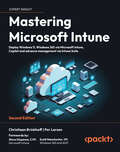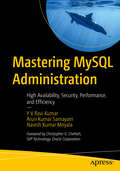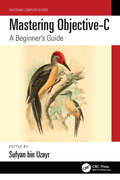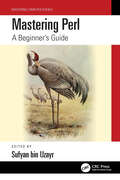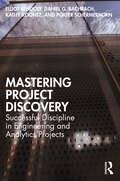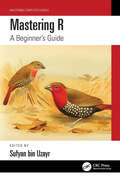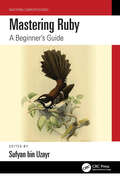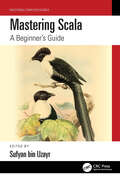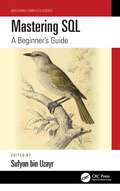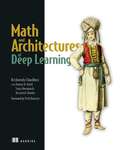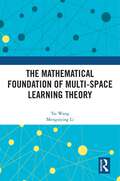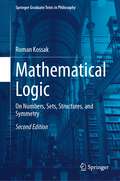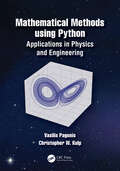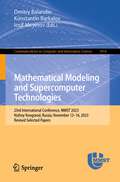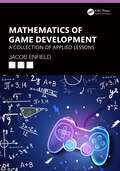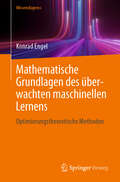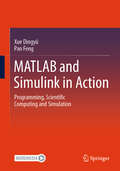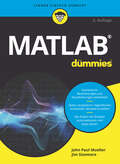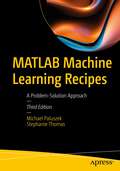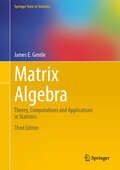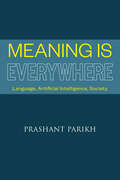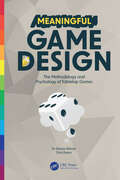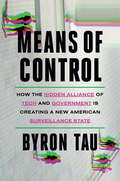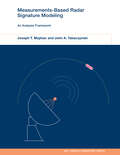- Table View
- List View
Mastering Microsoft Intune: Deploy Windows 11, Windows 365 via Microsoft Intune, Copilot and advance management via Intune Suite
by Christiaan Brinkhoff Per LarsenGet ready to master Microsoft Intune and revolutionize your endpoint management strategy with this comprehensive guide and and provide next-level security with the Intune Suite. Includes forewords from Scott Manchester, Vice President, Windows 365 + AVD and Steve Dispensa Corporate Vice President, Microsoft Intune.Key FeaturesThis new edition covers the latest updates of Microsoft Intune, Windows 365, Intune Suite, Windows Autopatch, Microsoft Defender and Universal PrintGet detailed guidance on device enrolment, app deployment, management, data security, and policy configurationSecure data on personal devices with app policies, encryption, and moreBook DescriptionThe slow adoption of Modern Work solutions, which are designed to streamline the management of your environment, can often be attributed to a lack of understanding and familiarity with the product. This book will provide you with all the information you need to successfully transition to Microsoft Intune Mastering Microsoft Intune explains various concepts in detail to give you the clarity to plan how to use Microsoft Intune and eliminate potential migration challenges beforehand. You'll get to master Cloud Computing services such as Windows 365 Cloud PC, Intune Suite, Windows Autopatch, Windows Autopilot, profile management, monitoring and analytics, Universal Print, and much more. The book will take you through the latest features and new Microsoft cloud services to help you to get to grips with the fundamentals of Intune and understand which services you can manage. Whether you are talking about physical or cloud endpoints it's all covered. By the end of the book, you'll be able to set up Intune and use it to run Windows, and Windows 365 efficiently via Intune with all the latest features included. What you will learnSimplify the deployment of Windows in the cloud with Windows 365 Cloud PCDeliver next-generation security features with Intune suiteSimplify Windows Updates with Windows AutopatchConfigure advanced policy management within IntuneDiscover modern profile management and migration options for physical and cloud PCsHarden security with baseline settings and other security best practicesFind troubleshooting tips and tricks for Intune, Windows 365 Cloud PC, and moreDiscover deployment best practices for physical and cloud-managed endpointsWho this book is forIf you are an IT professional, enterprise mobility administrator, architect, or consultant looking to learn about managing Windows on both physical and cloud endpoints using Microsoft Intune, then this book is for you.
Mastering MySQL Administration: High Availability, Security, Performance, and Efficiency
by Y V Ravi Kumar Arun Kumar Samayam Naresh Kumar MiryalaThis book is your one-stop resource on MySQL database installation and server management for administrators. It covers installation, upgrades, monitoring, high availability, disaster recovery, security, and performance and troubleshooting. You will become fluent in MySQL 8.2, the latest version of the highly scalable and robust relational database system.With a hands-on approach, the book offers step-by-step guidance on installing, upgrading, and establishing robust high availability and disaster recovery capabilities for MySQL databases. It also covers high availability with InnoDB and NDB clusters, MySQL routers and enterprise MySQL tools, along with robust security design and performance techniques. Throughout, the authors punctuate concepts with examples taken from their experience with large-scale implementations at companies such as Meta and American Airlines, anchoring this practical guide to MySQL 8.2 administration in the real world.What YouWill LearnUnderstand MySQL architecture and best practices for administration of MySQL serverConfigure high availability, replication, disaster recovery with InnoDB and NDB enginesBack up and restore with MySQL utilities and tools, and configure the database for zero data lossTroubleshoot with steps for real-world critical errors and detailed solutionsWho This Book Is ForTechnical professionals, database administrators, developers, and engineers seeking to optimize MySQL databases for scale, security, and performance
Mastering Objective-C: A Beginner's Guide (Mastering Computer Science)
by Sufyan Bin UzayrMastering Objective-C is a detailed guide for beginners that gives a modern programmer’s viewpoint on Objective-C. It introduces the principles of Objective-C and current Apple programming skills and libraries allowing the reader to make the best use of the tools available. Concise and easy to understand, this book covers many topics including, an introduction to key concepts of language and primary toolkits, as well as the Foundation and AppKit frameworks to help quickly advance with the necessary information. This book explains how to structure applications properly and organize code for optimum performance. The fundamental principles explained here are helpful to beginner and intermediate users interested in learning this highly technological and diverse language.
Mastering Perl: A Beginner's Guide (Mastering Computer Science)
by Sufyan Bin UzayrMastering Perl helps readers to learn the Perl programming language with real-world examples. High-level, interpreted, and multipurpose, Perl’s roots are in text manipulation. It is used for UI development in system administration, networking, and other fields, borrowing heavily from C and Shell scripts. Among programmers, Perl is also known as "Pathologically Eclectic Rubbish Lister" or "Practically Everything Really Likable." Since Perl’s inception, it has mostly been used for text processing, namely the extraction of data from text files and its subsequent transformation into other formats. In addition to being interoperable with HTML, XML, and other markup languages, Perl provides cross-platform compatibility. It is Open Source, meaning it is free to use and licensed under both the Artistic and GNU General Public Licenses (GPL). With Mastering Perl, learning Perl becomes a charm and will help readers undoubtedly advance their careers.
Mastering Project Discovery: Successful Discipline in Engineering and Analytics Projects
by Elliot Bendoly Daniel Bachrach Kathy Koontz Porter SchermerhornIntroducing a comprehensive approach to invigorate project leadership, this book provides a framework – the OUtCoMES Cycle – for developing, managing, advancing, and optimizing engineering and analytics projects.All too often, issues of moral hazard and completion bias prevent engineering and analytics managers and team leaders from asking the critical question 'What’s the problem?', before committing time, energy, and resources to solve it. This book draws attention to the definition, structuring, option consideration and ultimately the addressing of the right problems, exploring the OUtCoMES Cycle framework that facilitates and energizes systematic thinking, knowledge sharing, and on-the-fly adjustment with an explicit focus on the maximization of value and ROI. Each chapter includes discussions and lessons in analytical and engineering problem identification, problem structuring, iterative problem development (mental and computational) and problem resolution, at least three embedded real-world case studies, and a closing 'Practitioner’s Recap' to contextualize key chapter takeaways.Written by a team of established academic scholars and practicing analysts and engineers, this is an accessible and culture-shifting action guide for instructors interested in training the next generation of project and analytics leaders, students of analytics and engineering, as well as practicing project leaders and principals.
Mastering R: A Beginner's Guide (Mastering Computer Science)
by Sufyan Bin UzayrR is a statistical computing and graphics programming language that you can use to clean, analyze, and graph data. It is widely used by researchers from various disciplines to estimate and display results and by teachers of statistics and research methods. This book is a detailed guide for beginners to understand R with an explanation of core statistical and research ideas. One of the powerful characteristics of R is that it is open-source, which means that anyone can access the underlying code used to run the program and add their own code for free. It will always be able to perform the latest statistical analyses as soon as anyone thinks of them. R corrects mistakes quickly and transparently and has put together a community of programming and statistical experts that you can turn to for help. Mastering R: A Beginner’s Guide not only explains how to program but also how to use R for visualization and modeling. The fundamental principles of R explained here are helpful to beginner and intermediate users interested in learning this highly technological and diverse language.
Mastering Ruby: A Beginner's Guide (Mastering Computer Science)
by Sufyan Bin UzayrRuby is a superb programming language used for a variety of activities such as developing desktop applications, static websites, computational services, and even automation systems. Mastering Ruby: A Beginner’s Guide is a detailed guide for beginners to understand Ruby. This book discusses how to structure applications properly and organize code for optimum performance. Concise and easy to understand, this book provides the fundamentals for web programming along with software development and simple app development. It covers a variety of topics, starting from syntax styles workflow for the Command line to creating websites that will quickly advance necessary information. The key principles about Ruby explained here are helpful to beginners and users interested in learning this highly technological and diverse language. Key Features: • Follows a hands-on approach and offers practical lessons and tutorials related to Ruby. • Provides an in-depth discussion of Ruby design and applications to help build robust knowledge. • Explains how to create individual websites using Ruby programming.
Mastering Scala: A Beginner's Guide (Mastering Computer Science)
by Sufyan Bin UzayrScala is a multi-paradigm, general-purpose scripting language. It is a completely object-oriented programming language that supports a functional programming technique. This book is a detailed guide for beginners to understand Scala. Concise and easy to understand, Mastering Scala: A Beginner’s Guide covers a comprehensive understanding of Scala and its components, libraries, and advance concepts to help readers quickly advance with the necessary information. This book provides functional approaches for solving queries using Scala. The fundamental principles of Scala explained here are helpful to beginner and intermediate users interested in learning this highly technical and diverse language. Key Features: Follows a hands-on approach and offers practical lessons and tutorials related to Scala Includes detailed tutorials meant for beginners to Scala Discusses Scala in-depth to help build robust knowledge
Mastering SQL: A Beginner's Guide (Mastering Computer Science)
by Sufyan Bin UzayrMastering SQL helps readers gain a firm understanding of the Structured Query Language. Structured Query Language, more often known as SQL, is the de facto standard language for working with databases. It is a specialized language for handling data-related tasks like creating a database, putting information into tables, modifying and extracting that information, and much more. MySQL, PostgreSQL, Oracle, SQL light, etc. are only a few examples of SQL implementations. SQL is a fast and efficient database system. SQL allows for the rapid and efficient retrieval of huge numbers of data entries from a database. It’s a relational database. Thus, data is described in a more orderly fashion than in an unstructured database like MongoDB. Insertions, deletions, inquiries, manipulations, and computations of data through analytical queries in a relational database may all be performed in a matter of seconds. With Mastering SQL, learning SQL becomes straightforward; using this book and resource will undoubtedly help readers advance their careers. The Mastering Computer Science series is edited by Sufyan bin Uzayr, a writer and educator with over a decade of experience in the computing field.
Math and Architectures of Deep Learning
by Krishnendu ChaudhuryShine a spotlight into the deep learning &“black box&”. This comprehensive and detailed guide reveals the mathematical and architectural concepts behind deep learning models, so you can customize, maintain, and explain them more effectively.Inside Math and Architectures of Deep Learning you will find: Math, theory, and programming principles side by side Linear algebra, vector calculus and multivariate statistics for deep learning The structure of neural networks Implementing deep learning architectures with Python and PyTorch Troubleshooting underperforming models Working code samples in downloadable Jupyter notebooks The mathematical paradigms behind deep learning models typically begin as hard-to-read academic papers that leave engineers in the dark about how those models actually function. Math and Architectures of Deep Learning bridges the gap between theory and practice, laying out the math of deep learning side by side with practical implementations in Python and PyTorch. Written by deep learning expert Krishnendu Chaudhury, you&’ll peer inside the &“black box&” to understand how your code is working, and learn to comprehend cutting-edge research you can turn into practical applications. Foreword by Prith Banerjee. About the technology Discover what&’s going on inside the black box! To work with deep learning you&’ll have to choose the right model, train it, preprocess your data, evaluate performance and accuracy, and deal with uncertainty and variability in the outputs of a deployed solution. This book takes you systematically through the core mathematical concepts you&’ll need as a working data scientist: vector calculus, linear algebra, and Bayesian inference, all from a deep learning perspective. About the book Math and Architectures of Deep Learning teaches the math, theory, and programming principles of deep learning models laid out side by side, and then puts them into practice with well-annotated Python code. You&’ll progress from algebra, calculus, and statistics all the way to state-of-the-art DL architectures taken from the latest research. What's inside The core design principles of neural networks Implementing deep learning with Python and PyTorch Regularizing and optimizing underperforming models About the reader Readers need to know Python and the basics of algebra and calculus. About the author Krishnendu Chaudhury is co-founder and CTO of the AI startup Drishti Technologies. He previously spent a decade each at Google and Adobe. Table of Contents 1 An overview of machine learning and deep learning 2 Vectors, matrices, and tensors in machine learning 3 Classifiers and vector calculus 4 Linear algebraic tools in machine learning 5 Probability distributions in machine learning 6 Bayesian tools for machine learning 7 Function approximation: How neural networks model the world 8 Training neural networks: Forward propagation and backpropagation 9 Loss, optimization, and regularization 10 Convolutions in neural networks 11 Neural networks for image classification and object detection 12 Manifolds, homeomorphism, and neural networks 13 Fully Bayes model parameter estimation 14 Latent space and generative modeling, autoencoders, and variational autoencoders A Appendix
The Mathematical Foundation of Multi-Space Learning Theory
by Tai Wang Mengsiying LiThis book explores the measurement of learning effectiveness and the optimization of knowledge retention by modeling the learning process and building the mathematical foundation of multi-space learning theory.Multi-space learning is defined in this book as a micro-process of human learning that can take place in more than one space, with the goal of effective learning and knowledge retention. This book models the learning process as a temporal sequence of concept learning, drawing on established principles and empirical evidence. It also introduces the matroid to strengthen the mathematical foundation of multi-space learning theory and applies the theory to vocabulary and mathematics learning, respectively. The results show that, for vocabulary learning, the method can be used to estimate the effectiveness of a single learning strategy, to detect the mutual interference that might exist between learning strategies, and to predict the optimal combination of strategies. In mathematical learning, it was found that timing is crucial in both first learning and second learning in scheduling optimization to maximize the intersection effective interval.The title will be of interest to researchers and students in a wide range of areas, including educational technology, learning sciences, mathematical applications, and mathematical psychology.
Mathematical Logic: On Numbers, Sets, Structures, and Symmetry (Springer Graduate Texts in Philosophy #4)
by Roman KossakThis textbook is a second edition of the successful, Mathematical Logic: On Numbers, Sets, Structures, and Symmetry. It retains the original two parts found in the first edition, while presenting new material in the form of an added third part to the textbook. The textbook offers a slow introduction to mathematical logic, and several basic concepts of model theory, such as first-order definability, types, symmetries, and elementary extensions. Part I, Logic Sets, and Numbers, shows how mathematical logic is used to develop the number structures of classical mathematics. All necessary concepts are introduced exactly as they would be in a course in mathematical logic; but are accompanied by more extensive introductory remarks and examples to motivate formal developments. The second part, Relations, Structures, Geometry, introduces several basic concepts of model theory, such as first-order definability, types, symmetries, and elementary extensions, and shows how they are usedto study and classify mathematical structures. The added Part III to the book is closer to what one finds in standard introductory mathematical textbooks. Definitions, theorems, and proofs that are introduced are still preceded by remarks that motivate the material, but the exposition is more formal, and includes more advanced topics. The focus is on the notion of countable categoricity, which analyzed in detail using examples from the first two parts of the book. This textbook is suitable for graduate students in mathematical logic and set theory and will also be of interest to mathematicians who know the technical aspects of the subject, but are not familiar with its history and philosophical background.
Mathematical Methods using Python: Applications in Physics and Engineering
by Vasilis Pagonis Christopher Wayne KulpThis advanced undergraduate textbook presents a new approach to teaching mathematical methods for scientists and engineers. It provides a practical, pedagogical introduction to utilizing Python in Mathematical and Computational Methods courses. Both analytical and computational examples are integrated from its start. Each chapter concludes with a set of problems designed to help students hone their skills in mathematical techniques, computer programming, and numerical analysis. The book places less emphasis on mathematical proofs, and more emphasis on how to use computers for both symbolic and numerical calculations. It contains 182 extensively documented coding examples, based on topics that students will encounter in their advanced courses in Mechanics, Electronics, Optics, Electromagnetism, Quantum Mechanics etc.An introductory chapter gives students a crash course in Python programming and the most often used libraries (SymPy, NumPy, SciPy, Matplotlib). This is followed by chapters dedicated to differentiation, integration, vectors and multiple integration techniques. The next group of chapters covers complex numbers, matrices, vector analysis and vector spaces. Extensive chapters cover ordinary and partial differential equations, followed by chapters on nonlinear systems and on the analysis of experimental data using linear and nonlinear regression techniques, Fourier transforms, binomial and Gaussian distributions. The book is accompanied by a dedicated GitHub website, which contains all codes from the book in the form of ready to run Jupyter notebooks. A detailed solutions manual is also available for instructors using the textbook in their courses.Key Features:· A unique teaching approach which merges mathematical methods and the Python programming skills which physicists and engineering students need in their courses.· Uses examples and models from physical and engineering systems, to motivate the mathematics being taught.· Students learn to solve scientific problems in three different ways: traditional pen-and-paper methods, using scientific numerical techniques with NumPy and SciPy, and using Symbolic Python (SymPy).Vasilis Pagonis is Professor of Physics Emeritus at McDaniel College, Maryland, USA. His research area is applications of thermally and optically stimulated luminescence. He taught courses in mathematical physics, classical and quantum mechanics, analog and digital electronics and numerous general science courses. Dr. Pagonis’ resume lists more than 200 peer-reviewed publications in international journals. He is currently associate editor of the journal Radiation Measurements. He is co-author with Christopher Kulp of the undergraduate textbook “Classical Mechanics: a computational approach, with examples in Python and Mathematica” (CRC Press, 2020). He has also co-authored four graduate-level textbooks in the field of luminescence dosimetry, and most recently published the book “Luminescence Signal analysis using Python” (Springer, 2022).Christopher Kulp is the John P. Graham Teaching Professor of Physics at Lycoming College. He has been teaching undergraduate physics at all levels for 20 years. Dr. Kulp’s research focuses on modelling complex systems, time series analysis, and machine learning. He has published 30 peer-reviewed papers in international journals, many of which include student co-authors. He is also co-author of the undergraduate textbook “Classical Mechanics: a computational approach, with examples in Python and Mathematica” (CRC Press, 2020).
Mathematical Modeling and Supercomputer Technologies: 23rd International Conference, MMST 2023, Nizhny Novgorod, Russia, November 13–16, 2023, Revised Selected Papers (Communications in Computer and Information Science #1914)
by Dmitry Balandin Konstantin Barkalov Iosif MeyerovThis book constitutes selected and revised papers from the 23rd International Conference on Mathematical Modeling and Supercomputer Technologies, MMST 2023, held in Nizhny Novgorod, Russia, during November 13–16 2023. The 18 full papers and 7 short papers presented in the volume were thoroughly reviewed and selected from the 45 submissions. They are organized in topical sections as follows: computational methods for mathematical models analysis; computation in optimization and optimal control; artificial intelligence and supercomputer simulation.
Mathematics of Game Development: A Collection of Applied Lessons
by Jacob EnfieldThis introductory textbook introduces students to mathematical concepts and helps them to understand how they apply to the field of game development. This book covers the mathematical concepts commonly used in game development while providing opportunities to apply these concepts in the industry-standard Unity game engine.Most chapters cover mathematical concepts commonly used in game development, a downloadable game project that will provide a context to apply the math concepts learned, exercises for readers to practice the math concepts covered, and challenges for readers to further practice applying those concepts.This book will be ideal for any game development student looking to gain a grounding in the most relevant mathematical concepts to support their trade. It will also be useful as a stepping stone to digesting more advanced mathematical concepts for game development.
Mathematische Grundlagen des überwachten maschinellen Lernens: Optimierungstheoretische Methoden
by Konrad EngelDieses Buch behandelt die gängigsten Methoden zur Klassifikation von digitalisierten Objekten. Jedem Objekt ist ein Punkt im Euklidischen Raum passender Dimension zugeordnet. Das Lernen basiert auf einer Menge von Punkten, für die die zugehörige Klasse bekannt ist. Eine Reduktion der Dimension sowie elementare und anspruchsvollere Methoden zur Ermittlung schnell berechenbarer Funktionen, mit denen man aus einem Punkt die zugehörige Klasse mit einer möglichst geringen Fehlerrate ableiten kann, werden hergeleitet und in einer einheitlichen Herangehensweise begründet. Die recht elementaren Beweise werden im Wesentlichen mit Mitteln der Linearen Algebra geführt, nur für die neuronalen Netze wird etwas Analysis benötigt.Die Produktfamilie WissensExpress bietet Ihnen Lehr- und Lernbücher in kompakter Form. Die Bücher liefern schnell und verständlich fundiertes Wissen.
MATLAB and Simulink in Action: Programming, Scientific Computing and Simulation
by Dingyü Xue Feng PanThe textbook is intended for teaching MATLAB language and its applications. The book is composed of three parts: MATLAB programming, scientific computing with MATLAB, and system simulation with Simulink. Since MATLAB is widely used in all fields of science and engineering, a good introduction to the language can not only help students learn how to use it to solve practical problems, but also provide them with the skills to use MATLAB independently in their later courses and research. The three parts of the book are well-balanced and tailored to the needs of engineering students, and the mathematical problems commonly encountered in engineering can be easily solved using MATLAB. This textbook is suitable for undergraduate and graduate students majoring in science and engineering.
Matlab für Dummies (Für Dummies)
by Jim Sizemore John Paul MuellerMATLAB® So lernen Sie MATLAB ideal zu nutzen Ob Naturwissenschaftler, Mathematiker, Ingenieur oder Datenwissenschaftler - mit MATLAB haben Sie ein mächtiges Tool in der Hand, das Ihnen die Arbeit mit Ihren Daten erleichtert. Aber wie das mit manch mächtigen Dingen so ist - es ist auch ganz schön kompliziert. Aber keine Sorge! Die Autoren führen Sie in diesem Buch Schritt für Schritt an das Programm heran - von der Installation und den ersten Skripten bis hin zu aufwändigen Berechnungen, der Erstellung von Grafiken und effizienter Fehlerbehebung. Sie werden begeistert sein, was Sie mit MATLAB alles anstellen können. Sie erfahren Was es mit dem MATLAB-Dateisystem auf sich hat Wie Sie mathematische Operationen mit Vektoren und Matrizen durchführen Wie Sie Funktionen und Skripte erstellen Wie Sie importieren, exportieren und publizieren.
MATLAB Machine Learning Recipes: A Problem-Solution Approach
by Michael Paluszek Stephanie ThomasHarness the power of MATLAB to resolve a wide range of machine learning challenges. This new and updated third edition provides examples of technologies critical to machine learning. Each example solves a real-world problem, and all code provided is executable. You can easily look up a particular problem and follow the steps in the solution.This book has something for everyone interested in machine learning. It also has material that will allow those with an interest in other technology areas to see how machine learning and MATLAB can help them solve problems in their areas of expertise. The chapter on data representation and MATLAB graphics includes new data types and additional graphics. Chapters on fuzzy logic, simple neural nets, and autonomous driving have new examples added. And there is a new chapter on spacecraft attitude determination using neural nets. Authors Michael Paluszek and Stephanie Thomas show how all of these technologies allow you to build sophisticated applications to solve problems with pattern recognition, autonomous driving, expert systems, and much more.What You Will LearnWrite code for machine learning, adaptive control, and estimation using MATLABUse MATLAB graphics and visualization tools for machine learningBecome familiar with neural netsBuild expert systemsUnderstand adaptive controlGain knowledge of Kalman FiltersWho This Book Is ForSoftware engineers, control engineers, university faculty, undergraduate and graduate students, hobbyists.
Matrix Algebra: Theory, Computations and Applications in Statistics (Springer Texts in Statistics)
by James E. GentleThis book presents the theory of matrix algebra for statistical applications, explores various types of matrices encountered in statistics, and covers numerical linear algebra. Matrix algebra is one of the most important areas of mathematics in data science and in statistical theory, and previous editions had essential updates and comprehensive coverage on critical topics in mathematics.This 3rd edition offers a self-contained description of relevant aspects of matrix algebra for applications in statistics. It begins with fundamental concepts of vectors and vector spaces; covers basic algebraic properties of matrices and analytic properties of vectors and matrices in multivariate calculus; and concludes with a discussion on operations on matrices, in solutions of linear systems and in eigenanalysis. It also includes discussions of the R software package, with numerous examples and exercises.Matrix Algebra considers various types of matrices encountered in statistics, such as projection matrices and positive definite matrices, and describes special properties of those matrices; as well as describing various applications of matrix theory in statistics, including linear models, multivariate analysis, and stochastic processes. It begins with a discussion of the basics of numerical computations and goes on to describe accurate and efficient algorithms for factoring matrices, how to solve linear systems of equations, and the extraction of eigenvalues and eigenvectors. It covers numerical linear algebra—one of the most important subjects in the field of statistical computing. The content includes greater emphases on R, and extensive coverage of statistical linear models. Matrix Algebra is ideal for graduate and advanced undergraduate students, or as a supplementary text for courses in linear models or multivariate statistics. It’s also ideal for use in a course in statistical computing, or as a supplementary text forvarious courses that emphasize computations.
May Contain Lies: How Stories, Statistics, and Studies Exploit Our Biases—And What We Can Do about It
by Alex EdmansHow our biases cause us to fall for misinformation—and how to combat it. Our lives are minefields of misinformation. It ripples through our social media feeds, our daily headlines, and the pronouncements of politicians, executives, and authors. Stories, statistics, and studies are everywhere, allowing people to find evidence to support whatever position they want. Many of these sources are flawed, yet by playing on our emotions and preying on our biases, they can gain widespread acceptance, warp our views, and distort our decisions. In this eye-opening book, renowned economist Alex Edmans teaches us how to separate fact from fiction. Using colorful examples—from a wellness guru’s tragic but fabricated backstory to the blunders that led to the Deepwater Horizon disaster to the diet that ensnared millions yet hastened its founder’s death—Edmans highlights the biases that cause us to mistake statements for facts, facts for data, data for evidence, and evidence for proof. Armed with the knowledge of what to guard against, he then provides a practical guide to combat this tide of misinformation. Going beyond simply checking the facts and explaining individual statistics, Edmans explores the relationships between statistics—the science of cause and effect—ultimately training us to think smarter, sharper, and more critically. May Contain Lies is an essential read for anyone who wants to make better sense of the world and better decisions.
Meaning Is Everywhere: Language, Artificial Intelligence, Society
by Prashant ParikhMeaning Is Everywhere sketches a theory of meaning from the ground up—with potentially profound consequences. In a sweeping narrative that arcs from the origins of meaning through the emergence of present-day science and technology, Prashant Parikh offers a fresh perspective on some of the most significant challenges and opportunities of the contemporary world, including the promise of AI, relief from scarcity and polarization, and the possibility of at least partial utopias.
Meaningful Game Design: The Methodology and Psychology of Tabletop Games
by Devon Allcoat Chris EvansThis book provides readers with the tools and methods with which to create effective tabletop games. It covers the design and development process thoroughly, guiding readers through the necessary mechanics, messages, and motivations of games that must be understood in order to build successful tabletop games, including serious educational games for teaching or training. Through a range of learning activities and methodologies, readers will develop an understanding of games and an appreciation for the creating and testing of game play whilst critically exploring the relationship between games, motivation, and learning. It includes chapters on design methodology, narrative, accessibility, playtesting, and more. This book will be of great interest to students of game design and serious game design courses. It will also appeal to designers, educators, and hobbyists interested in designing and developing their own tabletop games, educational or otherwise.
Means of Control: How the Hidden Alliance of Tech and Government Is Creating a New American Surveillance State
by Byron TauYou are being surveilled right now. This sweeping exposé reveals how the U.S. government allied with data brokers, tech companies, and advertisers to monitor us through the phones we carry and the devices in our home.&“A revealing . . . startling . . . timely . . . fascinating, sometimes terrifying examination of the decline of privacy in the digital age.&”—Kirkus Reviews&“That evening, I was given a glimpse inside a hidden world. . . . An entirely new kind of surveillance program—one designed to track everyone.&”For the past five years—ever since a chance encounter at a dinner party—journalist Byron Tau has been piecing together a secret story: how the whole of the internet and every digital device in the world became a mechanism of intelligence, surveillance, and monitoring.Of course, our modern world is awash in surveillance. Most of us are dimly aware of this: Ever get the sense that an ad is &“following&” you around the internet? But the true potential of our phones, computers, homes, credit cards, and even the tires underneath our cars to reveal our habits and behavior would astonish most citizens. All of this surveillance has produced an extraordinary amount of valuable data about every one of us. That data is for sale—and the biggest customer is the U.S. government.In the years after 9/11, the U.S. government, working with scores of anonymous companies, many scattered across bland Northern Virginia suburbs, built a foreign and domestic surveillance apparatus of breathtaking scope—one that can peer into the lives of nearly everyone on the planet. This cottage industry of data brokers and government bureaucrats has one directive—&“get everything you can&”—and the result is a surreal world in which defense contractors have marketing subsidiaries and marketing companies have defense contractor subsidiaries. And the public knows virtually nothing about it.Sobering and revelatory, Means of Control is the defining story of our dangerous grand bargain—ubiquitous cheap technology, but at what price?
Measurements-Based Radar Signature Modeling: An Analysis Framework (MIT Lincoln Laboratory Series)
by Joseph T. Mayhan John A. TabaczynskiA high-level text that synthesizes diverse research areas for characterizing objects (targets) from radar data and establishes a novel analysis framework for a class of signal processing techniques useful for high-resolution radar signature modeling.The only text to integrate a diverse body of work on characterizing objects (targets) from radar data into a common analysis framework, this book brings together the results of research papers and technical reports providing improved resolution and precision in radar target signature modeling and target motion solutions. It offers comprehensive coverage related to basic radar concepts, signal representation, and radar measurements; the development of advanced analysis tools essential for high-resolution signature modeling; the development of novel wideband and narrowband radar imaging techniques; the application of 2D spectral estimation theory to wideband signal processing; ultra-wideband scattering phenomenology and sparse-band sensor data fusion; and the integration of field measurements into the radar signature modeling process. The analysis techniques developed in the text provide the framework for a novel approach, called measurements-based modeling (MBM), to model target signatures by incorporating measurement data into the signature model of the target. Extensive examples throughout compare the performance of the new techniques with that of conventional analysis techniques.The first systematic, comprehensive synthesis of wide-ranging research areas for characterizing targets from radar data A deeply researched, lucid presentation enriched by extensive illustrations and examples An essential reference for experts in radar and signal processing, professional engineers in related fields, and graduate students
